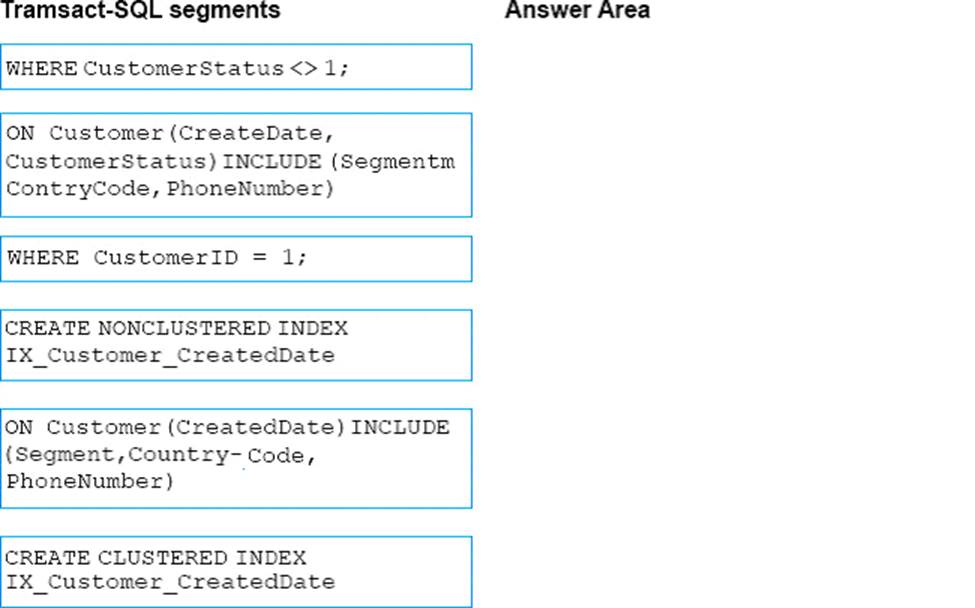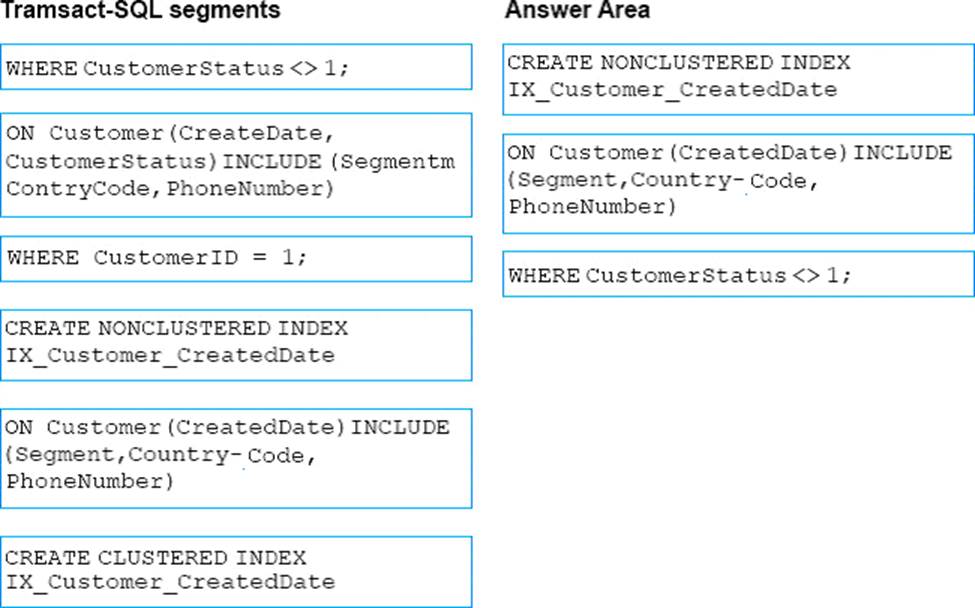Microsoft 70-762 Developing SQL Databases Online Training
Microsoft 70-762 Online Training
The questions for 70-762 were last updated at Feb 15,2025.
- Exam Code: 70-762
- Exam Name: Developing SQL Databases
- Certification Provider: Microsoft
- Latest update: Feb 15,2025
Users must be able to retrieve an account number by supplying customer information.
You need to implement the design changes while minimizing data redundancy.
What should you do?
- A . Split the table into three separate tables. Include the AccountNumber and CustomerID columns in the first table. Include the CustomerName and Gender columns in the second table. Include the AccountStatus column in the third table.
- B . Split the table into two separate tables. Include AccountNumber, CustomerID, CustomerName and Gender columns in the first table. Include the AccountNumber and AccountStatus columns in the second table.
- C . Split the table into two separate tables, Include the CustomerID and AccountNumber columns in the first table. Include the AccountNumber, AccountStatus, CustomerName and Gender columns in the second table.
- D . Split the table into two separate tables, Include the CustomerID, CustomerName and Gender columns in the first table. Include AccountNumber, AccountStatus and CustomerID columns in the second table.
Users must be able to retrieve an account number by supplying customer information.
You need to implement the design changes while minimizing data redundancy.
What should you do?
- A . Split the table into three separate tables. Include the AccountNumber and CustomerID columns in the first table. Include the CustomerName and Gender columns in the second table. Include the AccountStatus column in the third table.
- B . Split the table into two separate tables. Include AccountNumber, CustomerID, CustomerName and Gender columns in the first table. Include the AccountNumber and AccountStatus columns in the second table.
- C . Split the table into two separate tables, Include the CustomerID and AccountNumber columns in the first table. Include the AccountNumber, AccountStatus, CustomerName and Gender columns in the second table.
- D . Split the table into two separate tables, Include the CustomerID, CustomerName and Gender columns in the first table. Include AccountNumber, AccountStatus and CustomerID columns in the second table.
Users must be able to retrieve an account number by supplying customer information.
You need to implement the design changes while minimizing data redundancy.
What should you do?
- A . Split the table into three separate tables. Include the AccountNumber and CustomerID columns in the first table. Include the CustomerName and Gender columns in the second table. Include the AccountStatus column in the third table.
- B . Split the table into two separate tables. Include AccountNumber, CustomerID, CustomerName and Gender columns in the first table. Include the AccountNumber and AccountStatus columns in the second table.
- C . Split the table into two separate tables, Include the CustomerID and AccountNumber columns in the first table. Include the AccountNumber, AccountStatus, CustomerName and Gender columns in the second table.
- D . Split the table into two separate tables, Include the CustomerID, CustomerName and Gender columns in the first table. Include AccountNumber, AccountStatus and CustomerID columns in the second table.
Users must be able to retrieve an account number by supplying customer information.
You need to implement the design changes while minimizing data redundancy.
What should you do?
- A . Split the table into three separate tables. Include the AccountNumber and CustomerID columns in the first table. Include the CustomerName and Gender columns in the second table. Include the AccountStatus column in the third table.
- B . Split the table into two separate tables. Include AccountNumber, CustomerID, CustomerName and Gender columns in the first table. Include the AccountNumber and AccountStatus columns in the second table.
- C . Split the table into two separate tables, Include the CustomerID and AccountNumber columns in the first table. Include the AccountNumber, AccountStatus, CustomerName and Gender columns in the second table.
- D . Split the table into two separate tables, Include the CustomerID, CustomerName and Gender columns in the first table. Include AccountNumber, AccountStatus and CustomerID columns in the second table.
Users must be able to retrieve an account number by supplying customer information.
You need to implement the design changes while minimizing data redundancy.
What should you do?
- A . Split the table into three separate tables. Include the AccountNumber and CustomerID columns in the first table. Include the CustomerName and Gender columns in the second table. Include the AccountStatus column in the third table.
- B . Split the table into two separate tables. Include AccountNumber, CustomerID, CustomerName and Gender columns in the first table. Include the AccountNumber and AccountStatus columns in the second table.
- C . Split the table into two separate tables, Include the CustomerID and AccountNumber columns in the first table. Include the AccountNumber, AccountStatus, CustomerName and Gender columns in the second table.
- D . Split the table into two separate tables, Include the CustomerID, CustomerName and Gender columns in the first table. Include AccountNumber, AccountStatus and CustomerID columns in the second table.
Contains all of the columns required by the SELECT statement.
Which three Transact_SQL segments should you use to develop the solution? To answer, move the appropriate code blocks from the list of code blocks to the answer area and arrange them in the correct order.

Contains all of the columns required by the SELECT statement.
Which three Transact_SQL segments should you use to develop the solution? To answer, move the appropriate code blocks from the list of code blocks to the answer area and arrange them in the correct order.

Contains all of the columns required by the SELECT statement.
Which three Transact_SQL segments should you use to develop the solution? To answer, move the appropriate code blocks from the list of code blocks to the answer area and arrange them in the correct order.

Contains all of the columns required by the SELECT statement.
Which three Transact_SQL segments should you use to develop the solution? To answer, move the appropriate code blocks from the list of code blocks to the answer area and arrange them in the correct order.

Contains all of the columns required by the SELECT statement.
Which three Transact_SQL segments should you use to develop the solution? To answer, move the appropriate code blocks from the list of code blocks to the answer area and arrange them in the correct order.

Latest 70-762 Dumps Valid Version with 157 Q&As
Latest And Valid Q&A | Instant Download | Once Fail, Full Refund


